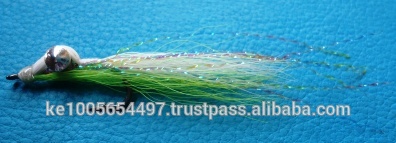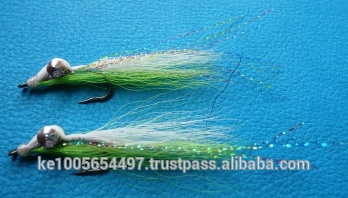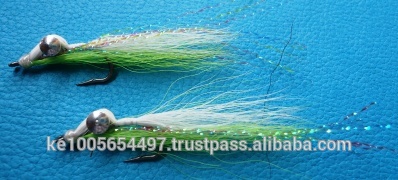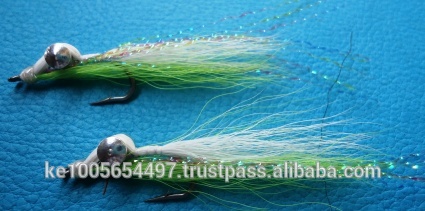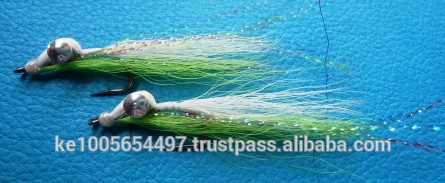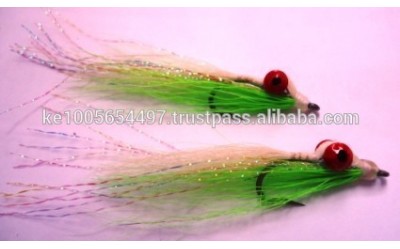Material List:
- For freshwater: Hook= Mustad 3366 in size 4, 6, 8 (Saltwater hook: Mustad 34007 or Gamakatsu sc15)
- Lead eyes appropriate for hook size. I tend to use larger eyes than used in commercial flies. I want my flies to get deep quickly and have a pronounced jigging action.
- Flashabou or crystal flash: I use very little flash in my flies. 2-4 strands at the max. I think too much flash spooks fish.
- Bucktail color combos:
- Chartreuse over white
- Gray over white
- Yellow over white
- Olive over tan
- Tan over white
- Olive over rust over tan
- Blue over pink over white
- All white
- All black
- Alternate body material: Sometimes even sparsely dressed Clousers look too "opaque" in clear water. Occasionally you'll see chases with last minute refusals or just get no response from the fish at all. When that happens, I turn to Clousers tied with synthetic materials rather than bucktail. My favorite synthetic is called Slinky Fibre (and Slinky Blend... blended colors of Slinky Fibre) from Umpqua. Search for it on the net and you'll find that lots of companies offer it. It maintains a nice profile in the water while having a translucent appearance. It is also the least annoying of all synthetics I have tried in terms of flies tangling together. Slinky Fibre doesn't become inexorably tangled in itself. Tangled yes... but fairly easy to get undone.
Tying steps:
1) Place hook in vise, hook point down. Tie in lead eyes on the top of the hook shank: Wrap the eyes in about the equivalent length from the hook eye as the length of the lead eyes themselves. 1/4 to 3/8 inch is usually about right depending on the size of your fly. A nice trick for securing metal eyes to a hook: Take an emery board and sand a little of the lacquer coating off of a bronze hook. Wrap the thread into place, add a drop of Loctite super glue on the bare hook area, place the eyes on the super glue, position them quickly and wrap in with thread. (If the metal eyes are painted, also scrape some of the paint off to expose the metal underneath.) This gives you a “metal-to-metal” bond. Use figure eight wraps, locking wraps, and encircling wraps to secure them in place. The super glue will soak into the thread and make a very strong bond. Let the superglue dry. This will prevent the eyes from spinning around the hook shank. No need to sand down stainless hooks. Just add the super glue for a metal-to-metal bond.
2) Measure the bottom color of bucktail to be about 2.5 to 3 times the length of the entire hook. Tie it in by the tips in front of the lead eyes. While stretching the bucktail back into the space between the lead eyes, move the thread behind the lead eyes and, using soft wraps, tie the bucktail to the hook shank behind the eyes. Tie it down as far back as the hook point (or farther if the hook shank is still straight and not starting into the bend). Remember to use "soft but firm" wraps. If you torque down too hard on the thread you will cut or flare the bucktail. Use alot of softer wraps rather than excessively tight wraps. Advance the thread forward to in front of the lead eyes.
3) Turn the fly over (hook point up). Cut 2-4 pieces of flash (optional) the length of the bucktail and tie it in front of the lead eyes, streaming back over the bottom bucktail. No need to use too many wraps on the flash as you will be adding another material on top of it. Use just use enough thread wraps to hold it in place securely for a few minutes.
4) Cut your top bucktail color about the same length as the bottom bucktail (about 2.5 to 3 times the hook length). Tie it in by the tip immediately behind the eye of the hook. Again, don't torque down on the thread. It will flare the bucktail. Use 6-10 soft wraps moving back towards the lead eyes to hold it in place. Then add a small drop of superglue on the butts and thread wraps. To finish the fly off, wrap the thread the rest of the way to cover the bucktail butts and make a uniform head shaped like a bullet.
5) Add head cement to the head and to the bottom bucktail where it passes between the lead eyes, as this is the area where Clousers receive the most wear and tear as they jig up and down, hitting rocks. Alternately, you can mix up some clear epoxy and put it on the head, the eyes and the area between the eyes. Bob Clouser's original recipe calls for the epoxy and the flies he sells are epoxied. I don't have the patience to mess with epoxy on a fly that will probably not survive too long when I'm guiding.
